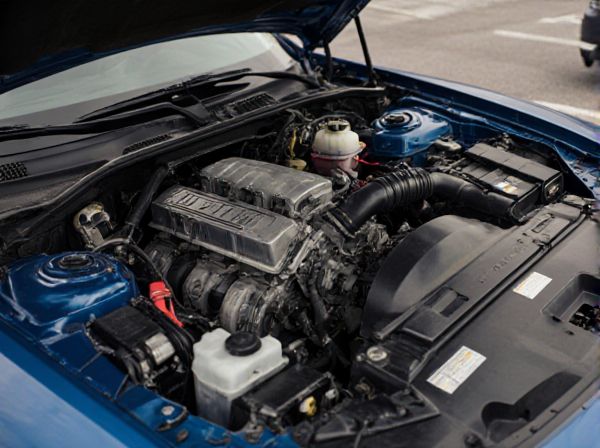
Photo illustration: Iron Block vs Aluminum Block
Iron blocks provide superior durability and wear resistance, making them ideal for heavy-duty or high-performance engines. Aluminum blocks are lighter, improving fuel efficiency and handling while offering good heat dissipation for better engine cooling. Your choice depends on whether you prioritize strength and longevity or weight reduction and thermal efficiency.
Table of Comparison
| Feature | Iron Block | Aluminum Block |
|---|---|---|
| Material | Cast Iron | Aluminum Alloy |
| Weight | Heavier, increases engine weight | Lighter, improves fuel efficiency |
| Heat Dissipation | Poor heat conductor | Excellent heat conductor |
| Durability | High strength, resistant to wear | Less durable, prone to warping under extreme heat |
| Cost | Lower production cost | Higher manufacturing cost |
| Performance Impact | Increased engine weight reduces performance | Weight reduction enhances acceleration & handling |
| Common Use | Trucks, heavy-duty engines | Sports, high-performance vehicles |
Introduction to Engine Block Materials
Iron blocks offer superior strength and durability due to their high tensile strength and resistance to wear, making them ideal for heavy-duty engines and long-lasting performance. Aluminum blocks provide significant weight reduction, improving fuel efficiency and handling, with enhanced heat dissipation that supports better engine cooling. Modern manufacturing techniques allow aluminum blocks to achieve comparable strength through reinforced alloys and advanced casting methods, balancing performance with lightweight advantages.
Overview of Iron and Aluminum Blocks
Iron blocks, known for their exceptional strength and durability, provide enhanced wear resistance and superior heat retention, making them ideal for heavy-duty engine applications. Aluminum blocks offer significant weight reduction, improved thermal conductivity, and better fuel efficiency due to their lightweight nature, which enhances engine performance and responsiveness. Both materials play critical roles in engine design, balancing factors such as strength, weight, heat dissipation, and manufacturing cost.
Weight Comparison: Iron vs Aluminum
Aluminum blocks weigh significantly less than iron blocks, with aluminum being approximately 40% to 50% lighter due to its lower density, around 2.7 g/cm3 compared to iron's 7.2 g/cm3. This weight difference translates into improved fuel efficiency and enhanced vehicle handling when using aluminum blocks in engine construction. Despite aluminum's lighter weight, iron blocks typically offer greater strength and durability, influencing their use in applications requiring higher structural integrity.
Strength and Durability Differences
Iron blocks offer superior tensile strength and wear resistance compared to aluminum blocks, making them more durable under high-stress engine conditions. Aluminum blocks are lighter and provide better heat dissipation but typically have lower strength, which can lead to faster wear in extreme performance applications. The choice between iron and aluminum blocks largely depends on the balance between the need for structural robustness and weight savings in engine design.
Heat Dissipation and Thermal Conductivity
Aluminum blocks outperform iron blocks in heat dissipation due to aluminum's higher thermal conductivity, typically around 205 W/m*K compared to iron's 80 W/m*K. This superior thermal conductivity enables aluminum engine blocks to transfer and dissipate heat more efficiently, reducing engine temperatures and improving performance. As a result, aluminum blocks contribute to better thermal management and enhanced durability in high-performance engines.
Performance Impact on Vehicles
Iron blocks provide superior strength and durability, making them ideal for high-performance vehicles requiring increased structural integrity and heat resistance. Aluminum blocks offer significant weight reduction, enhancing vehicle acceleration, fuel efficiency, and handling dynamics, but may sacrifice some long-term durability under extreme stress. The choice between iron and aluminum blocks directly impacts engine responsiveness, thermal management, and overall vehicle performance characteristics.
Cost Analysis: Manufacturing and Maintenance
Iron blocks have higher manufacturing costs due to complex casting processes and increased material weight, leading to greater production expenses. Aluminum blocks offer lower manufacturing costs because of lighter weight and easier machining, reducing energy consumption and tooling wear. Maintenance costs tend to be higher for iron blocks due to susceptibility to rust and corrosion, whereas aluminum blocks benefit from corrosion resistance but require careful handling to avoid warping and galvanic corrosion.
Corrosion Resistance Factors
Iron blocks exhibit superior corrosion resistance due to the presence of a stable oxide layer that protects against rust and environmental damage, especially in automotive engine applications. Aluminum blocks require protective coatings or anodizing treatments to prevent oxidation and pitting, as aluminum naturally forms a less durable oxide layer under harsh conditions. The enhanced corrosion resistance of iron blocks contributes to longer engine life and reduced maintenance in corrosive environments.
Applications and Use Cases
Iron blocks are commonly used in heavy-duty applications such as trucks, industrial machinery, and marine engines due to their superior strength and durability. Aluminum blocks are favored in automotive and aerospace industries where lightweight construction improves fuel efficiency and performance. High-performance sports cars often use aluminum blocks to reduce weight and enhance speed while maintaining adequate strength.
Choosing the Right Engine Block Material
Choosing the right engine block material depends on balancing weight, durability, and thermal conductivity. Iron blocks offer superior strength and wear resistance, making them ideal for heavy-duty and high-performance engines, while aluminum blocks provide significant weight savings and better heat dissipation, enhancing fuel efficiency and handling. Engine designers prioritize iron for longevity under stress and aluminum for lightweight construction and improved thermal management.
 caratoz.com
caratoz.com